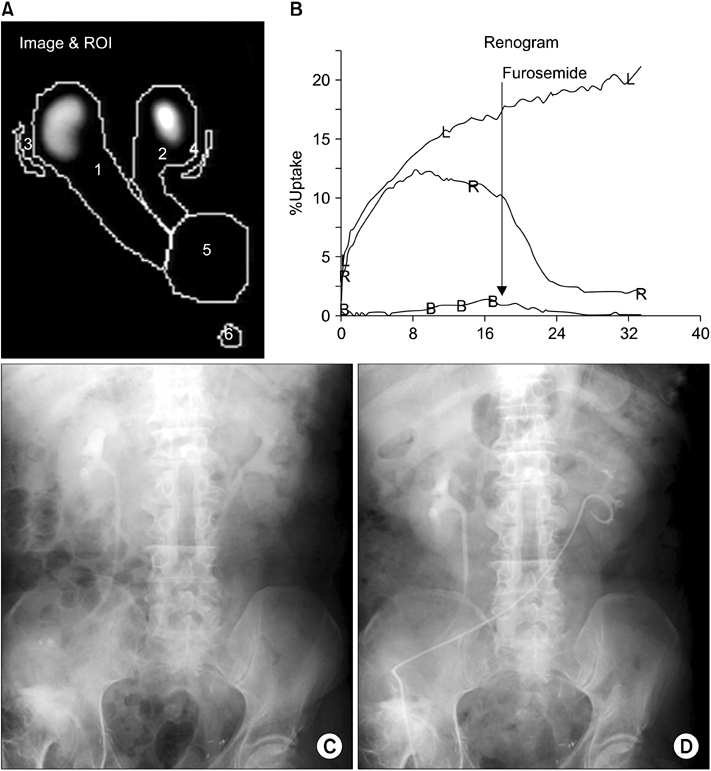Korean J Urol.
2013 May;54(5):322-326. 10.4111/kju.2013.54.5.322.
Diagnostic Criteria for Stomal Obstruction of Tubeless Cutaneous Ureterostomy by Use of 99mTc-Mercaptoacetyltriglycine Diuretic Renography
- Affiliations
-
- 1Department of Urology, Kohka Public Hospital, Kohka, Japan. cj-kim@belle.shiga-med.ac.jp
- KMID: 2061514
- DOI: http://doi.org/10.4111/kju.2013.54.5.322
Abstract
- PURPOSE
To evaluate 99mTc-mercaptoacetyltriglycine diuretic renograms for diagnosing stomal obstruction in tubeless cutaneous ureterostomy.
MATERIALS AND METHODS
Cutaneous ureterostomy was performed in 29 patients (56 renal units) with a minimum follow-up period of 12 months. Stomal obstruction was evaluated with 99mTc-mercaptoacetyltriglycine diuretic renography 3 months after surgery. Regions of interest were drawn that completely encircled and snugly fit the kidney, renal pelvis, and ureter. The data analyses were performed with half-times to tracer clearance following furosemide (0.5 mg/kg) administration.
RESULTS
The mean half-times to tracer clearance were 6.90+/-6.30, 5.25+/-4.29, and 8.75+/-7.63 minutes in the total, ipsilateral, and contralateral kidneys, respectively, in side relationships between the ureter and the stoma. There were significant differences between the ipsilateral and contralateral kidneys in the mean half-time to tracer clearance (p=0.038). Forty-eight renal units (85.7%) had a half-time to tracer clearance of less than 15 minutes, and all 48 renal units had no hydronephrosis. On the other hand, 5 renal units (8.9%) had a half-time to tracer clearance of more than 20 minutes, and these 5 renal units required the insertion of stent catheters or became atrophic.
CONCLUSIONS
99mTc-mercaptoacetyltriglycine diuretic renography was very useful for diagnosing stomal obstruction of tubeless cutaneous ureterostomy. The upper limit of the half-time to tracer clearance for unobstructed systems was 15 minutes, which allowed for the confident exclusion of stomal obstruction in tubeless cutaneous ureterostomy.
Keyword
MeSH Terms
Figure
Reference
-
1. Williams O, Vereb MJ, Libertino JA. Noncontinent urinary diversion. Urol Clin North Am. 1997. 24:735–744.2. Hirokawa M, Iwasaki A, Yamazaki A, Asakura S, Nozaki A, Yamagishi T. Improved technique of tubeless cutaneous ureterostomy and results of permanent urinary diversion. Eur Urol. 1989. 16:125–132.3. Ariyoshi A, Fusijawa Y, Ohshima K, Hiratsuka Y, Sakamoto K. Catheterless cutaneous ureterostomy. J Urol. 1975. 114:533–535.4. Toyoda Y. A new technique for catheterless cutaneous ureterostomy. J Urol. 1977. 117:276–278.5. Namiki T, Yanagi S. A new technique for bilateral single stoma loop cutaneous ureterostomy. J Urol. 1995. 154(2 Pt 1):361–363.6. Rainwater LM, Leary FJ, Rife CC. Transureteroureterostomy with cutaneous ureterostomy: a 25-year experience. J Urol. 1991. 146:13–15.7. Yoshimura K, Maekawa S, Ichioka K, Terada N, Matsuta Y, Okubo K, et al. Tubeless cutaneous ureterostomy: the Toyoda method revisited. J Urol. 2001. 165:785–788.8. Kim CJ, Wakabayashi Y, Sakano Y, Johnin K, Yoshiki T, Okada Y. Simple technique for improving tubeless cutaneous ureterostomy. Urology. 2005. 65:1221–1225.9. O'Reilly PH, Lawson RS, Shields RA, Testa HJ. Idiopathic hydronephrosis: the diuresis renogram: a new non-invasive method of assessing equivocal pelvioureteral junction obstruction. J Urol. 1979. 121:153–155.10. Kim CJ, Takimoto K, Tomita K, Osafune T, Nishikawa N, Johnin K, et al. Evaluation of hydronephrosis with tubeless cutaneous ureterostomy using Tc-99m MAG3 diuretic renography. Clin Nucl Med. 2009. 34:666–669.11. Straffon RA, Kyle K, Corvalan J. Techniques of cutaneous ureterostomy and results in 51 patients. J Urol. 1970. 103:138–146.12. Rodriguez AR, Lockhart A, King J, Wiegand L, Carrion R, Ordorica R, et al. Cutaneous ureterostomy technique for adults and effects of ureteral stenting: an alternative to the ileal conduit. J Urol. 2011. 186:1939–1943.13. Roarke MC, Sandler CM. Provocative imaging: diuretic renography. Urol Clin North Am. 1998. 25:227–249.14. Talner LB. Pollack HM, editor. Obstructive uropathy. Clinical urography. 1990. Philadelphia: Saunders;1535–1751.15. Kletter K, Nurnberger N. Diagnostic potential of diuresis renography: limitations by the severity of hydronephrosis and by impairment of renal function. Nucl Med Commun. 1989. 10:51–61.
- Full Text Links
- Actions
-
Cited
- CITED
-
- Close
- Share
- Similar articles
-
- Evaluations for Hydronephrosis After the Establishment of Tubeless Cutaneous Ureterostomy
- A clinical experience of urinary diversion: postoperative complications of diversion
- Comparison of Split Renal Function on DTPA Renal Scan and Endogenous Creatinine Clearance Ratio in Obstruction of Upper Urinary Tract
- Correlation between Ultrasonography and Diuretic Renography in Infants with Ureteropelvic Junction Obstruction
- Scintigraphic Assessment of Renal Function Using 99mTc-DTPA in Miniature Pigs with Unilateral Ureteral Obstruction



